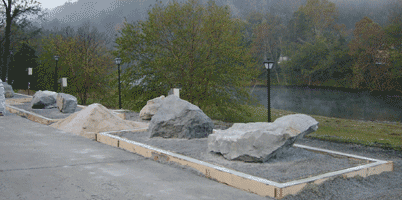|
|
|
 |
|
|
|
|
"Ethical action by artists needs to be oriented toward the long-term sustainability of the community and its urgent need for economic revitalization and ecosystem repair."
In Spring 2000, Suzanne Lacy was invited to participate in an "Artist in Community Gathering" in Eastern Kentucky, sponsored by the American Festival Project and Appalshop. This project was an attempt to create a structure for community engagement that would facilitate the deeper integration of arts into the lives of a series of small communities and towns throughout the region. The goal for the weeklong residency was to bring artists from across the country into contact with communities in a process of mutual exploration and exchange. At the end of the initial exploration period, the artists and participating community members retreated to The Breaks State Park for reflection.
From this group of forty or so artists, plans emerged for subsequent, sustained work in a series of sites. One of the most organized and active civic organizations was the Elkhorn City Heritage Council, who followed up with visiting artists in three different projects: a photography/video project with local high school students and artist Jessica _______, a resident-produced play at the cemetery with artist Louise Smith, and the current project with artists Lacy, Steinman, and Kobayashi.
Subsequently, Lacy re-visited Elkhorn City and in a series of site visits determined that the ecological expertise of Susan Steinman and Yutaka Kobayashi were important to the most prominent concerns of members of the Heritage Council. Guided consistently by Tim Belcher and Nina Aragon and other members of the Heritage Council, the artists' attention was directed to the waterfront area and the Council's on-going project to restore and revitalize it.
In Spring 2002, five students accompanied the artists on a weeklong spring break residency from California College of Arts to learn-by-doing in a community context.
During this intense week, students worked alongside artists and community residents to create a temporary landscape and installation at the site of the proposed pocket park by a red caboose at the waterfront. They also taught tile painting workshops for high school students and senior citizens, completing 400 tiles for use in the subsequent waterfront and walking path installation.
The students were tremendous assets. The town loved meeting them and sharing histories and personal stories. Many stories of the regions' land and rivers were collected for use in the installations. Students taught a journalism class at the local high school, visited a quarry to help select rock boulders and transport them back to town, produced a photo documentary of local churches, created a graffiti mural for the bathroom of Giovanni's Pizza Parlor, and still had time to learn about local culture.
Hampered by the scarcity of funding for arts groups after 911, the artists continued to meet in California and create, with the pro-bono work of landscape architect Laurel Kelly, a set of plans for a tile mural and waterfront pocket parks approved by the Elkhorn City Council. Approvals in hand, the artists sought funding from the Creative Capitol Foundation who provided them with a grant that will allow them, with careful managing of resources to take the project to the next stage, scheduled for completion in Spring 2004. See Project Description.
hree pocket parks will link parts of a walking trail along the south bank of the Russell River, across two bridges, and down the Main Street of town. Each park consists of seating made of granite boulders and poured concrete with text from local residents reminiscing about the river; plantings of trees and bushes; and markers made of tile and text. A recurring motive is the growth of plants between slices in the asphalt and the use of mixed scale regional granite, as gravel and as boulders. |
|
|
|
|